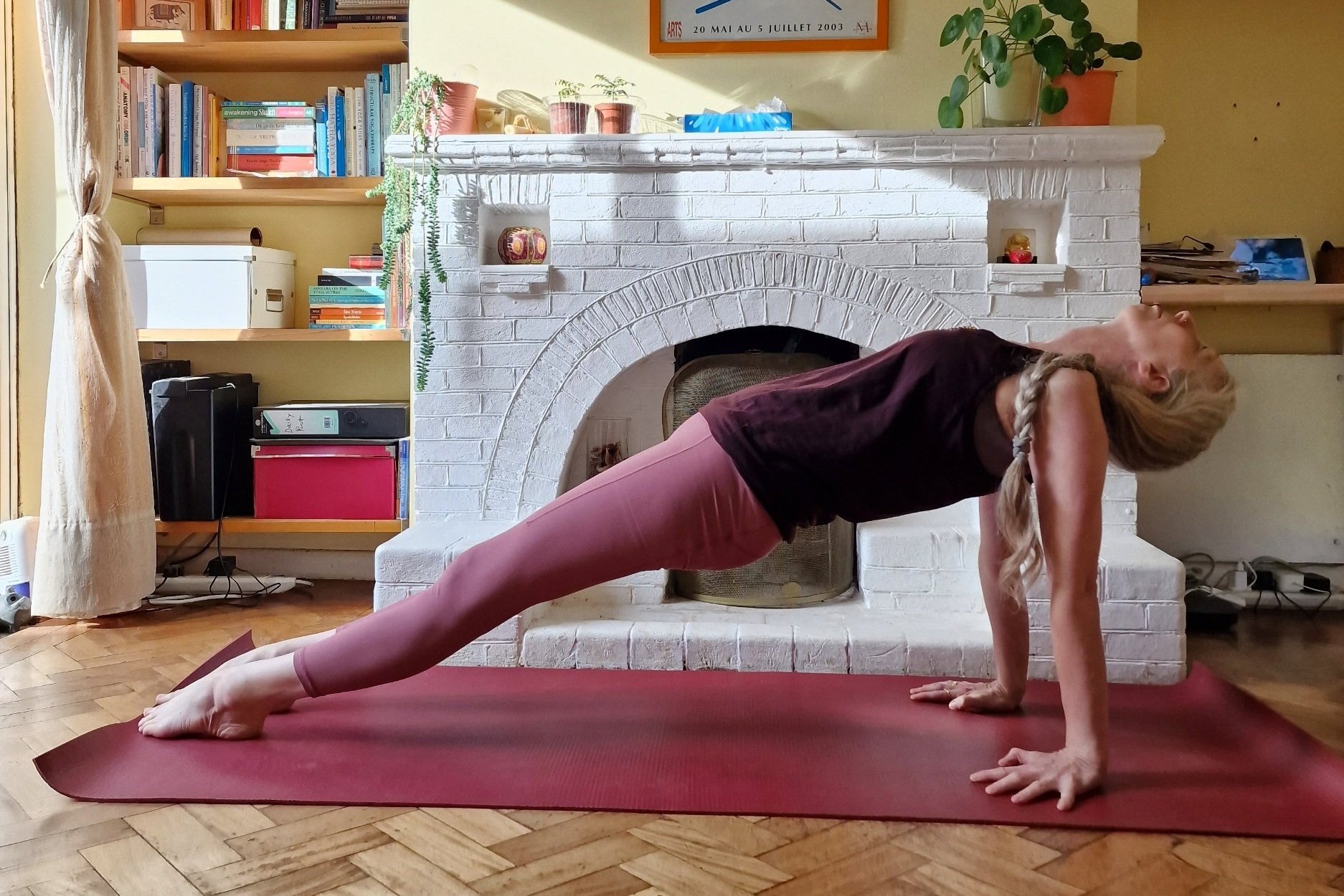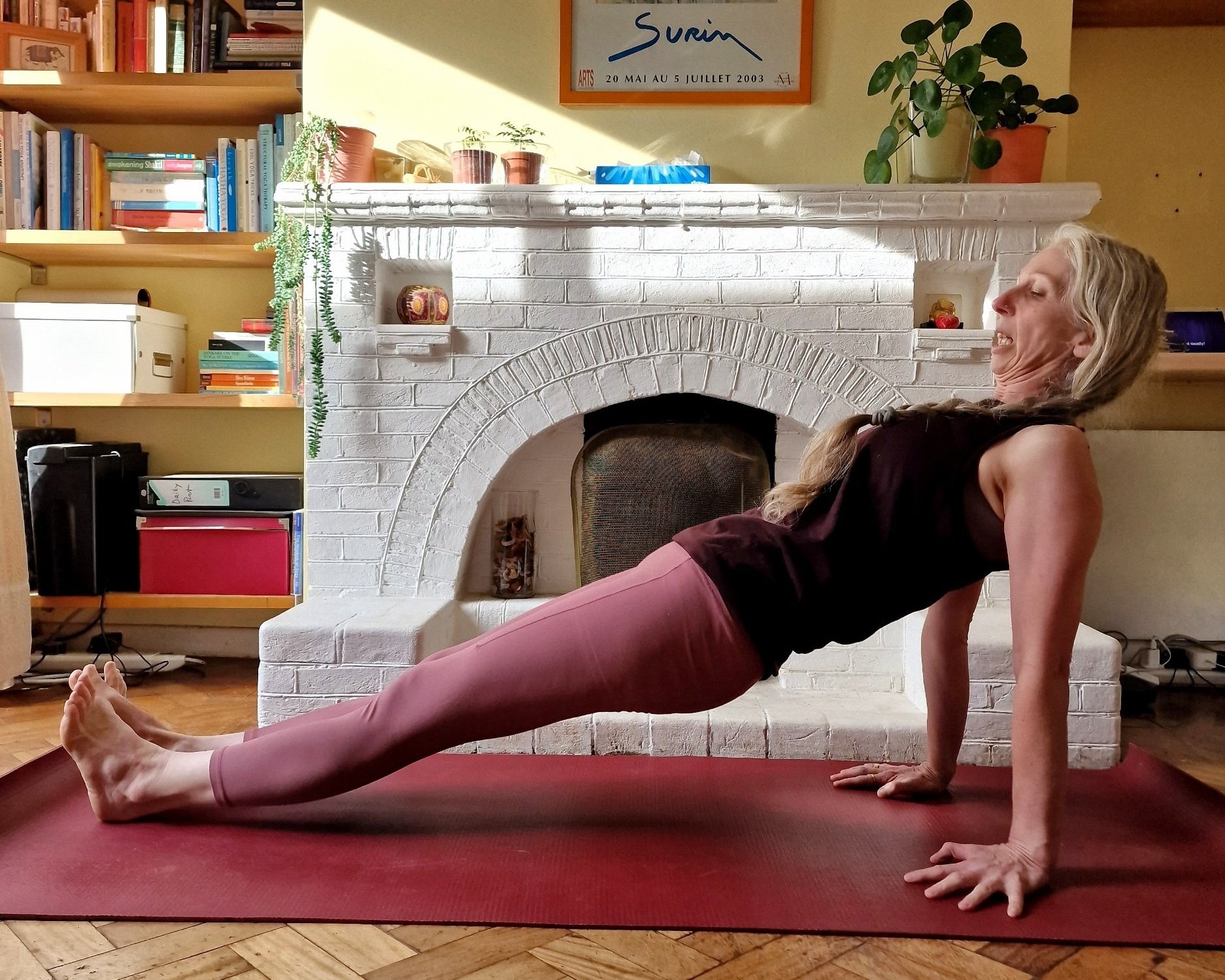Purvottanasana: Balance Effort and Ease in Upward Plank
Effort and ease, or Sthira Sukha, is a well-known Yoga concept from the Yoga Sutras that reminds us to balance both if we want to achieve a Yoga practice.
Yoga is about uniting the opposing principles, one being our likes and dislikes. We live in a dualistic world, and Yoga offers us a way to find balance. Balance is needed for our minds to be peaceful.
We prefer the likes for apparent reasons: we have experienced something we enjoyed and want to repeat the experience.
Equally, we want to avoid repeating an experience that we disliked, and we can go to a considerable effort to achieve this, avoiding something unpleasant.
And here goes our peace.
When was the last time that you tried to get around doing something that you didn't like? It could be doing the dishes, cooking, taking the dog out in the rain, etc. Even little tasks can set us off. In a family environment, this can lead to lengthy "why me?" discussions, which can take longer than the actual task.
These discussions obviously are not contributing to peace of mind. Agreed? Our mind has the habit of searching for further unhelpful scenarios that we have experienced. It presents us with material that we can throw into the discussion, which can take a completely different direction away from the original task. You get the picture. All that because we try to avoid something we don't like.
Practising Yoga is a beautiful tool to overcome these likes and dislikes.
Unlock your best autumn & winter yet. Dive into our FREE ULTIMATE AUTUMN/WINTER GUIDE!
Get Ayurveda tips, spot the imbalance, recipes, shopping list, Yoga sequences and more.
On the practical Side
The above principle applies also to our asana (Yoga posture) practice. Naturally, we like what we can do and don't like what challenges us physically or mentally.
In a class situation, we have the friendly and understanding 😊 Yoga teacher who encourages us to take a tiny little step towards the disliked pose. When fear is involved, all alarm bells ring, and it is clear, "I can't do that".
Overcoming this resistance by taking one step at a time, we encourage change. We see that we can do this. We know that we get better at it. It all helps even to start liking the pose after a while.
Here is the connection. Everything is based on experiences. When we have a "bad" experience, this gets logged in our mind as 'not to be repeated'. We deprive ourselves of making a different experience next time because there is no next time, full stop. On the mat, during Yoga sessions, we can overcome something we didn't like beforehand. Overcoming a dislike opens a little space in our mind where the thought of 'wow, I managed to go upside-down today, let's tackle this phone call that I put off since days' can surface, no matter what occasion. These are transferrable experiences.
When I started to practise Ashtanga Yoga with its set sequences, there were ample opportunities to overcome my likes and dislikes, as each pose is practised and held for five breaths, whether we like it or not.
When did you think the last time, "That wasn't so bad", after doing something that you didn't like, or even started enjoying the actual activity?
This is where the ease develops. By dropping the expectations and continuing to practise, another concept of (abhyasa and vairagya). We inch towards sthira sukha, effort and ease.
Purvottanasana is such a great Example!
Do you like the upward plank? It is not my favourite pose, but I don't mind it any longer. I practised it a gazillion times; now my shoulders are okay with it; I got stronger and don't feel the effort so much, and now I can explore the ease.
Patanjali said
Sthira sukham asanam.
Asana is a steady, comfortable posture. YS, II, 46
The asana (Yoga pose) is when we experience effort and ease at the same time. If it's only effort, we are not in a Yoga frame of mind, nor when there is too much ease.
With too much effort, we get rajasic, which means we get obsessed, overwriting our body's ability, and potentially hurt ourselves.
When there is too much ease, we get tamasic and complacent, our minds might drift, and we lose focus.
When we strike a balance between effort and ease, we are in a sattvic state of mind, which is conducive to the state of Yoga, balance, harmony, and peace of mind.
How to bring Balance in Purvottanasana
Purvottanasana - upward plank
Purva = east and uttana - intense stretch - intense stretch of the east side, which is the front of the body.
This pose is tricky for our shoulders, although we only extend the arms, which means they go behind our backs. There, they need to hold the weight of the upper body.
So, we need shoulder mobility to practise and master this pose. In addition, our back needs strength, the upper to hold the shoulders and chest and the lower to support the pelvis.
The entire front body is open (sukha), legs turning slightly in at the hips. The back body is engaged and needs strength (sthira).
With too much ease, we might open and over-extend our shoulders. If the strength is missing, often our pelvis drops, and it is straining to hold the pose. Both are needed.
The Benefits of Purvottanasana
The main benefit of Purvottanasana is the strengthening effect on the body, in particular: it
improves shoulder mobility and strength.
It strengthens the arms, particularly the back of the arms with the triceps.
helps with wrist strength and mobility.
strengthens the legs and opens the front of the ankles.
improves overall strength in the body.
helps to broaden our chest to counterbalance slouching and rounding of the shoulders.
opens the front of the hips, balancing the sitting throughout the day.
With so much strength (sthira) involved, you might ask where the ease comes in. Learning to breathe in this pose definitely adds an element of ease to it.
How to practise Purvottanasana?
Begin seated in Dandasana (Staff Pose) with your legs straight and your hands slightly behind your hips, with your fingertips pointing forward.
Roll your legs slightly in from your hips.
Roll your shoulders back, draw the shoulder blades towards the centre and let them slide down your back to open the chest.
As you inhale, press the floor away with your hands and heels and lift your hips off the floor.
Bring your foot soles on the floor, keep engaging your legs strongly, and press down through the big toes.
Keep your arms active to lift the chest bone towards the sky.
Allow your head to drop back, making sure the curve of your neck is a continuation of the curve of your upper back.
Hold for 5 slow breaths. Press into your feet and hands as you exhale; lift your hips and chest as you inhale.
With an exhale, release back to the floor.
How to make Upward Plank easier?
If the wrists are the issue, coming on the elbows helps as long as you work on your wrists.
Keep gazing towards your toes to support your neck.
Draw your toes towards your shins if the front of the ankle is tight.
Practising upside-down table or reverse table-top position, where the knees are bent, is an excellent starting point to get strength in the back.
Purvottanasana during the Seasons
Purvottanasana is great during the springtime. When practised with deep breathing, the pose creates warmth in the body and balances the cold Kapha qualities. Kapha is strong and has stamina, so the pose works excellently.
During the summer months, it is better hold the pose for a short time, particularly if it is challenging.
The autumn and winter months benefit from the warmth and strength that it creates. It is always important to practise to one’s own abilities. Both Pitta (summer) and Vata (autumn/winter) tire quickly and need to conserve their energy.
Final Thoughts
Yoga and Balance: The Yoga concept from the Yoga Sutras, Sthira Sukha, emphasises balancing effort and ease, which is crucial for a balancing Yoga practice. Yoga aids in reconciling dualities and achieving mental peace, especially when managing our likes and dislikes.
Practical Implications: While practising Yoga postures (asanas), we often face resistance towards challenging poses. Yet, by gradually approaching these poses, we can overcome our dislikes. Such experiences help develop transferable skills and cultivate resilience.
Purvottanasana is not a favourite for many. Frequent practice of the upward plank can transform the feeling of exertion into ease.
Challenges: The pose demands shoulder mobility and back strength. However, if not performed correctly, one might over-extend the shoulders or experience strain.
Benefits: Purvottanasana enhances shoulder mobility, counteracts slouching, strengthens the arms, legs, and wrists, and aids in opening the front of the hips and ankles.
Modifications: Variations like the reverse table-top position can serve as beginner-friendly alternatives.
By integrating both effort and ease in practices like Purvottanasana, one can achieve balance, harmony, and peace of mind, a core objective of Yoga.
Is Purvottanasana for you more effort or ease or a balance? Let me know what you think. You can leave a message on Instagram, Facebook or even good old email.
I love hearing from you!
Katja x
P.S. Why not integrating this dish during your Healthy Eating Habit Challenge :)



